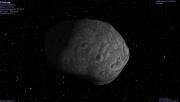Planetary Database/Terran/Mars/Phobos
The Planetary Database - Terran System - Mars - Phobos
Phobos was discovered by American astronomer Asaph Hall on August 18, 1877, at the US Naval Observatory in Washington, D.C., at about 09:14 GMT (contemporary sources, using the pre-1925 astronomical convention that began the day at noon, give the time of discovery as August 17 16:06 Washington mean time). [1]. Asaph Hall also discovered Deimos, Mars' other moon at the same time.
Physical characteristics
Phobos is a dark body that appears to be composed of C-type asteroid surface materials. It is similar to the C-type (blackish carbonaceous chondrite) asteroids that exist in the outer asteroid belt. Phobos's density is too low to be pure rock, however, and it is probably composed of a mixture of rock and ice.
The Soviet Union spacecraft Phobos 2 detected a faint but steady outgassing from Phobos. Unfortunately Phobos 2 failed before it could determine the nature of the material, but it is most likely water. Recent images from Mars Global Surveyor indicates that Phobos is covered with a layer of fine dust about a metre thick, similar to the regolith on the Earth's Moon.
Phobos is highly nonspherical, with dimensions of 27 × 21.6 × 18.8 km. It is heavily cratered, and the most prominent surface feature is the large crater named Stickney, after the maiden name of Asaph Hall's wife Chloe Angeline Stickney Hall. Like Mimas' crater Herschel on a smaller scale, the impact that created Stickney must have almost shattered Phobos. The grooves and streaks on the surface were probably also caused by the Stickney impact. The grooves are typically less than 30 m deep, 100 – 200 m wide, and up to 20 km in length.
The unique Kaidun meteorite is claimed to be a piece of Phobos, which fell on a Soviet Naval Base in Yemen in 1980, but this has been difficult to verify since little is known about the composition of the moon.